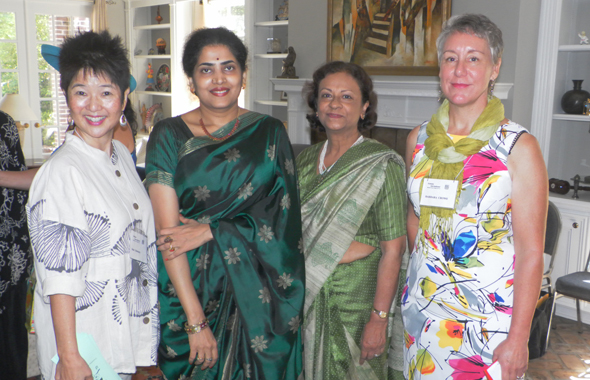For Ikebana Members, an Indian Perspective on Flower

From left: Dale Schawrz, Sushila Mathew and Barbara Crowe of the Houston Chapter of Ikebana International flank Nandita Parvathaneni (2nd from left). Photos: Jawahar Malhotra
By Jawahar Malhotra
HOUSTON: The Japanese are known for their minimalistic, yet beautiful flower arrangements that are in harmony with their surroundings. The art is known as Ikebana (Living Flowers) and has spread out across the world as people are captivated by the sheer creativity that turns even discarded petals and leaves into an art piece.
The local chapter of Ikebana International held its September event at the home of Nandita Parvathaneni, wife of the Indian Consul General, for members and their guests. The roomful of women sat in the large living room which had been cleared to make space for the event which began with a classical Kuchipudi dance invocating Ganesha by Shreya Bhadriraju and Amani Parvathaneni, students of the Anjali School of Performing Arts.
The ladies were then treated to a Ikebana flower arrangement demonstration by Shirley Bludau with the Ichiyo School of Ikebana. She started with an empty tall flower vase and then added some dried branches, discarded Bird of Paradise leaves (even the dried, curled up ones), a few snips of green bush tops and a couple of chrysanthemums (“The only thing I bought”, she quipped, “all $10.50 of them”!) and turned into a beautiful art piece.
Sushila Mathew who was the Program Chair of the Houston Chapter later exhibited a beautiful colorful piece that she had made herself. She was accompanied at the event by Chapter President Barbara Crowe and Board member Dale Schwarz.
Nandita Parvathaneni then explained the second part of the program which consisted of the flower arrangements that are used in India. “In the multi-cultural, multi-religious and multi-lingual mosaic that is India, flowers occupy a central role in all rites of passage – from birth, marriage to death”, she said. “In Hinduism, every flower has a particular association with specific deities and energies and are used to propitiate them and seek blessings”. She added that “flowers are God’s gift to mankind. They remind us of what is pure, elevating and transcendent in nature, and indeed, in our lives. They connect us to nature and the divine”.
She then introduced the four ladies from the BAPS Swaminarayan Temple in Stafford who had come to demonstrate the art of making garlands for the deities, and for special occasions as well as the rangoli designs they had made using colored rice, though it can easily be done with petals of flowers as well.
The ladies explained the procedure of cutting the flower stems close to the bud, using cotton thread to avoid shredding and a large quilting needle to string the flowers together. They explained the significance of the color of flowers in Hinduism (red, yellow and orange for weddings for example, and white for funerals). They completed making a short garland and placed it on a statue of a deity in the room.
The ladies then adjourned for a light lunch prepared by Nandita before concluding the event.
